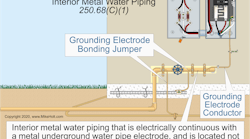Stumped by the Code? NEC Requirements for Connecting GECs and Bonding Jumpers to Grounding Electrodes
Courtesy of www.MikeHolt.com.
All questions and answers are based on the 2020 NEC.
Q. What are the Code requirements when connecting grounding electrode conductors and bonding jumpers to grounding electrodes?
A. Grounding electrode conductors (GECs) and bonding jumpers are permitted to terminate at the following locations and be used to extend the connection to an electrode(s) [Sec. 250.68(C)]:
(1) Interior metal water piping that is electrically continuous with a metal underground water pipe electrode and is located not more than 5 ft from the point of entrance to the building can be used to extend the connection to electrodes. Interior metal water piping located more than 5 ft from the point of entrance to the building is not permitted to be used as a conductor to interconnect electrodes of the grounding electrode system (Figure).
(2) The metal structural frame of a building can be used as a conductor to interconnect electrodes that are part of the grounding electrode system, or as a GEC where the hold‑down bolts secure the structural steel column to a concrete‑encased electrode [Sec. 250.52(A)(3)]. The hold‑down bolts must be connected to the concrete‑encased electrode by welding, exothermic welding, the usual steel tie wires, or other approved means.
(3) A rebar‑type concrete‑encased electrode [Sec. 250.52(A)(3)] with rebar extended to an accessible location above the concrete foundation or footing is permitted under the following conditions:
(a) The additional rebar section must be continuous with the grounding electrode rebar or must be connected to the grounding electrode rebar [250.52(A)(3)] and connected by the usual steel tie wires, exothermic welding, welding, or other effective means.
(b) The rebar extension is not permitted to be in contact with the earth.
(c) The rebar extension is not permitted to be used as a conductor to interconnect the electrodes of grounding electrode systems.
Author’s Comment:
- The most commonly specified type of rebar becomes very brittle where subjected to heat. Welding or exothermic welding to that type of rebar may not be identified for such use. Check with the structural engineer before making a connection with that type to rebar.
- Rebar located outdoors could be subject to corrosion.
These materials are provided to us by Mike Holt Enterprises in Leesburg, Fla. To view Code training materials offered by this company, visit www.mikeholt.com/code.






